Excited as always to introduce to you a new topic, I’d like to point out that this one was voted by my readers. Today we’ll take a look at Phoenician Jewelry. Don’t go thinking that I’ve only proposed this topic because I live in Phoenician land though. This civilization has truly made itself a place in Jewelry History; and yet I only learned about it while studying jewelry design in Florence, Italy.
Let’s get some context: Phoenicia is the name of the ancient territory corresponding to modern Lebanon, alongside parts of modern Syria and Palestine, with a big number of colonized cities throughout the Mediterranean. The main cities of Phoenicia were Sidon (modern Saida) as well as Tyre in South Lebanon, and Barot or Beritos (modern Beirut). The civilization spread across the Mediterranean between 1500 BC and 300 BC.

Map of ancient Phoenicia
Phoenicians are known for creating the modern alphabet (later on developed by the Greeks), for being exceptional maritime traders, as well as for their skills in working copper and other kind of metals (they were the first exporters of copper and silver). Aside of that, the contributions they made to the working of jewelry might be small, but not less significant.
The pieces that have survived until this day have been mostly found either in Phoenician temples (where they were stocked as offerings for the Gods) or in royal graves where they were buried along with the deads. Most of them are exhibited in various museums around the world, including the National Museum of Beirut, the Louvre and the Bardo in Tunis.
Jewelry manufacturing in Phoenicia was not only an artisanal tradition, but also an artistic one. Egyptian influences can be seen in the treasures found at Byblos (dating from 3 000 and 2 000 BC). Wide and massive necklaces covering the whole chest area, called pectorals, and made to protect the heart and lungs, were very common. Many of those were worked in “repoussé” (hammered into relief from the reverse side) or “cloisonné” (outlined with metal, resulting in cells or cloisons in french), as it was most commonly seen in Egyptian jewelry at the time. Some were entirely made in one single massive piece of metal, casted in specially created molds.

Pectoral worked in cloisonné
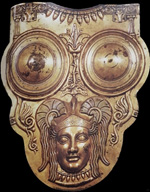
Pectoral worked in repoussé
Gold was not the only material to be used; a fairly big variety existed, but they are not all as resistant to the damages of time. Silver, bronze, polychrome glasses, precious stones and faience were also widely used in jewelry.
Phoenicians were especially famous to master the use of glass paste for the manufacture of beads.The most common bead shape made in this material was small head figurines, colorful and generally curly haired. Motives reminding us of the evil eye were very frequent as well.


Beads made in polychrome vitreous paste, also known as glass paste.

According to specialists, polychrome glass paste is an original invention to replace precious stones whose research was often difficult and expensive. These pieces were made in the cities of East Phoenicia (cities of current Lebanon: Byblos, Saida, Tyr…) as well as in other territories under Phoenician influence – like Carthage (current Tunis), Tharros & Syracuse (current Sicily), and today’s Ibiza.
Now back to gold jewelry. The most regularly seen shapes and patterns, if not religious themes, used to be nature-inspired or geometrical: lotus flowers, palmettes, rosettes; scarabs, hawks, sphinxes, griffins – those last few strongly reminding us of the Egyptian aesthetic.
Some very popular pieces are the Ankh shaped gold earrings (cross with handle) and rotating bezel ring with rounded corners, often decorated in the Egyptian style (see pictures below). Many pieces of the sort can be seen in Beirut’s National Museum.

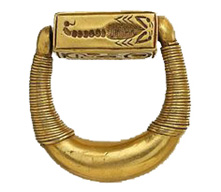
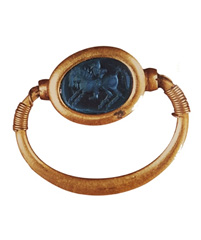
Ankh earrings made in high carat gold – Mobile bezel rings with scarab shapes
Phoenicians also worked a very important jewelry technique that has been further developed by another civilization called the Etruscans (who were based in today’s Italy): the granulé.
Let’s get a little technical: granulation is a jewelry technique in which a surface is covered in tiny granules of precious metal. Those are generally made from the same metal as the base to which they will be fixed. To make those granules, very tiny fringes are cut along the edge of a thin sheet of metal and then melted into small globules.

Close up on a granulated gold bead
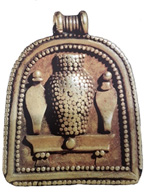
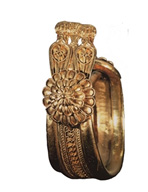
Granulation in jewelry requires a very sophisticated technique and we can still see it in some modern pieces today. This alone explains the advanced goldsmithing skills of the Phoenicians.
Another outstanding piece worth mentioning about Phoenician jewelry was the fibula. The fibula is a brooch or pin that was used to fasten or decorate clothing. The word itself comes from the latin fibulae, referring to a human leg bone. Obtained from a single gold rod, the metal is forged int to a triangular shape, reminding us of an inverted bow (see picture below).

Gold fibula found in the Phoenician Royal Tomb in Cyprus
Phoenicians were deeply inspired by the Egyptian aesthetic and themes in their jewelry. Their skills in goldsmithing led them to develop and excel in some techniques like granulation and of course the glass paste technique. This one was quiet original and revolutionary at the time, and continues to inspire contemporary jewelers today.
© 2021 Paola Sleiman. All rights reserved.


